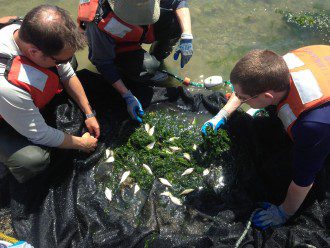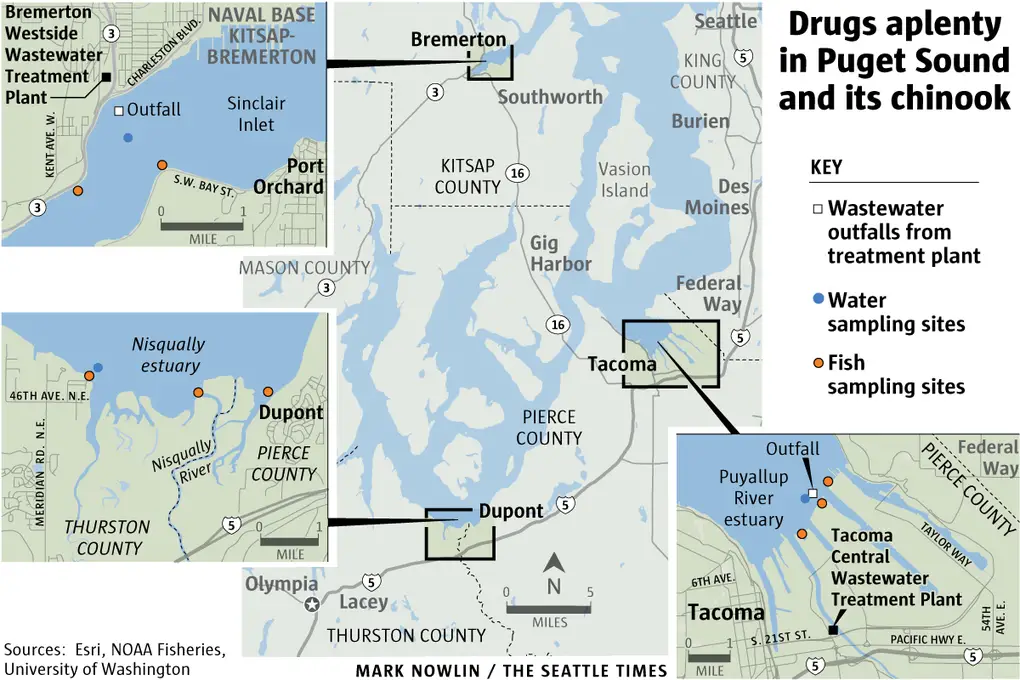Contributing Writer for Wake Up World
“From Prozac to caffeine to cholesterol medicine, from ibuprofen to bug spray, researchers found an alphabet soup of drugs and other personal-care products in sewage-treatment wastewater and in the tissue of juvenile chinook in Puget Sound.” ~ Seattle Times
Tainted Wastewater Poisons Salmon
A paper published in the journal Environmental Pollution has given a fresh meaning to the phrase “you are what you eat” — but this time, it’s in reference to the polluted diet of Pacific Northwest chinook salmon. Once hailed as an exceptionally healthy food, salmon has come under scrutiny as the ecosystem has become increasingly toxic from industrial waste, plastics, microbeads, general pollution and now, sewage treatment plants.
[pro_ad_display_adzone id=”110028″]
The research was conducted in the Puget Sound area near Seattle, Washington, and found the amount of drugs and chemicals dumped into waterways could be as much as 97,000 pounds a year. This cocktail of toxins involved 81 different pharmaceuticals and personal-care products — including antidepressants like Paxil and Zoloft, narcotic pain relievers such as Oxycontin and Darvon, along with a range of antibiotics, fungicides, insecticides, antiseptics and anticoagulants. In some instances, cocaine, DEET and female reproductive hormones were also detected.
Who knew salmon could be ‘high’ on cocaine?
“The concentrations in effluent [an outflowing of water] were higher than we expected. We analyzed samples for 150 compounds and we had 61 percent of them detected in effluent. So we know these are going into the estuaries.” ~ Jim Meador, environmental toxicologist at NOAA’s Northwest Fisheries Science Center in Seattle
Thanks to tainted wastewater discharge from sewage-treatment plants, Puget Sound salmon are testing at alarming levels of various prescription drugs, caffeine, personal-care products and a host of other toxins. Scientists wanted to find out why the levels were so high.
Samples were taken in the autumn of 2014 from Sinclair Inlet off Bremerton and near the mouth of Blair Waterway, both within range of Seattle. Migratory juvenile chinook salmon and resident staghorn sulpin were both found to contain a range of chemicals. It’s believed that, if anything, the paper most likely underestimated the amount of drugs in places close to outfall pipes, or in deeper water.
Surprisingly, even fish tested from the control waters of the Nisqually estuary came back positive for a variety of chemicals. According to the researchers, the estuary was thought to be pristine, especially since it receives no direct municipal treatment plant discharge. It was contaminated with different types of drugs — including cocaine, Cipro and Zantac. Researchers suspect leaking septic systems are a possible source of the drugs.
“That was supposed to be our clean reference area,” Meador told the Seattle Times. He also was surprised that levels in many cases were higher than in many of the 50 largest wastewater-treatment plants around the nation. Those plants were sampled in another study by the EPA. (source)
Betsy Cooper, permit administrator for the county’s Wastewater Treatment Division, points out:
You have treatment doing its best to remove these, chemically and biologically, but it’s not just the treatment quality, it’s also the amount that we use day-to-day and our assumption that it just goes away. But not everything goes away.
For instance, seizure drugs are exceptionally difficult to remove, and ibuprofen amounts are lowered, but not completely taken out.
Sadly, this isn’t the first time salmon have come under investigation for contamination.
Scottish farmed salmon found to be ‘full of cancer toxins’
“We think it’s important for people who eat salmon to know that farmed salmon have higher levels of toxins than wild salmon from the open ocean.” ~ Professor Ronald Hites of Indiana University
A survey in 2004 found farmed Atlantic salmon from Scotland contains the highest level of cancer-causing chemicals on the planet. So much so that it should only be consumed once every four months, according to American guidelines. If you decide to tempt fate and eat it more frequently, scientists say it will increase the risk of cancer by at least 1 in 100,000.
The results of the study were published in Science magazine. The list of cancer-causing chemicals discovered in the fish include PCBs, dieldrin, dioxins and toxaphene — all of which were substantially more concentrated in farmed salmon compared to their wild counterparts. The Scottish farmed fish had up to 10 times the toxins than wild salmon from Kodiak, Alaska.
And it wasn’t only Scottish fish, most European farmed salmon were found to have high concentrations of cancer-causing chemicals — levels so elevated that it’s not recommended to eat more than 200g every other month. The researchers believe the culprit is contaminated fish feed. To lower the risk, farms should use more plant-based material for food. Since toxins concentrate in fatty tissue, consumers can also remove as much skin and fat as possible from farmed salmon before eating.
Some don’t agree with the study’s findings and recommendations. Sir John Krebs, chairman of the Food Standards Agency, remarked:
Our advice is that people should consume at least two portions of fish a week — one of which should be oily like salmon. There is good evidence that eating oily fish reduces the risk of death from recurrent heart attacks and that there is a similar effect in relation to first heart attacks.We advise that the known benefits of eating one portion of oily fish outweigh any possible risks.
Article sources
- http://www.seattletimes.com/seattle-news/environment/drugs-flooding-into-puget-sound-and-its-salmon/
- http://www.sciencedirect.com/science/article/pii/S0269749116300884
- http://www.telegraph.co.uk/food-and-drink/news/your-salmon-might-be-high-on-cocaine/
- https://weather.com/news/news/salmon-caught-near-seattle-tested-positive-for-wide-range-of-drugs
- http://www.telegraph.co.uk/news/science/science-news/3317547/Scottish-farmed-salmon-is-full-of-cancer-toxins.html
About the author:
 Carolanne Wright enthusiastically believes if we want to see change in the world, we need to bethe change. As a nutritionist, natural foods chef and wellness coach, Carolanne has encouraged others to embrace a healthy lifestyle of organic living, gratefulness and joyful orientation for over 13 years.
Carolanne Wright enthusiastically believes if we want to see change in the world, we need to bethe change. As a nutritionist, natural foods chef and wellness coach, Carolanne has encouraged others to embrace a healthy lifestyle of organic living, gratefulness and joyful orientation for over 13 years.
Through her website Thrive-Living.net, she looks forward to connecting with other like-minded people from around the world who share a similar vision.
You can also follow Carolanne on Facebook, Twitter and Pinterest.
Further reading from Carolanne Wright:
- Seed Bombs: A Creative (and Fun) Mission to Save the Bees and Butterflies
- Mind Control, Subliminal Messages and the Brainwashing of America
- Autistic Boy with Higher IQ Than Einstein Discovers Gift After Removal from State-Run Therapy
- Monsanto Charged with Crimes Against Nature and Humanity – Set to Stand Trial in 2016
- Dr Sebi: The Man Who Cures Aids, Cancer, Diabetes and More
- Politicians in California May Soon be Forced to Wear Corporate Sponsor Patches Like Nascar Drivers
- Plastic-Eating Mushroom Discovered in the Amazon Rainforest — A Solution for Our Trash Saturated World?
- Big Pharma and Organized Crime — They are More Similar Than You May Think
- Over 100 Scientific Studies Agree: Cannabis Annihilates Cancer
- Emotional Energetic Healing: The Future of Medicine is Here
- Why Every Parent Should Consider Unschooling
- The Greenhouse of the Future: Grow Your Own Food Year-Round With This Revolutionary System
- First U.S. City Produces More Electricity Than It Uses — With 100% Renewable Technology
Photo by Andrew Yeh.
[pro_ad_display_adzone id=”110027″]








